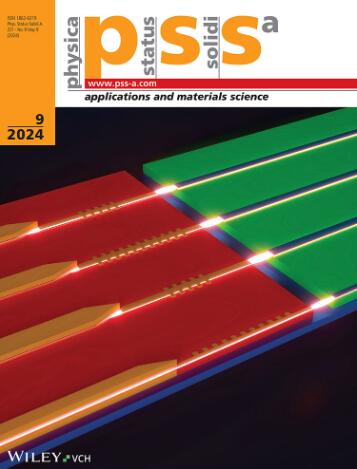优化 GaInN/GaN 多量子壳纳米线 LED 中 p-AlGaN 电子阻挡层的铝成分
IF 1.9
4区 材料科学
Q3 MATERIALS SCIENCE, MULTIDISCIPLINARY
Physica Status Solidi A-applications and Materials Science
Pub Date : 2024-07-02
DOI:10.1002/pssa.202400116
引用次数: 0
摘要
我们的目标是开发基于氮化镓/氮化镓纳米线 (NW) 的高效发光二极管 (LED),这种二极管由氮化镓纳米线和多量子壳 (MQS) 有源区组成。这些区域包括极性 c 平面、非极性 r 平面和半极性 m 平面。MQS-LED 面临的一个挑战是,在低电流注入条件下,通过 c 平面 MQS 的电流路径往往占主导地位。由于 c 平面上的 MQS 缺陷很大,注入电流主要受非辐射重组的影响。因此,本研究对 p-AlGaN 电子阻挡层 (EBL) 进行了各种优化,以尽量减少注入 c 平面区域 MQS 的电流。样品随后采用特定工艺生长。这涉及 n-GaN NW、基于 GaInN/GaN 的量子壳、不同铝成分的 pAlGaN EBL 和 p-GaN 壳。所有这些都是通过在具有二氧化硅孔图案的 n-GaN 模板上进行金属有机气相外延而形成的。NW LED 制作完成后,对其器件特性进行了研究。在低电流注入条件下,铝成分较低的样品表现出较高的发光强度。然而,当注入电流增大时,这一趋势发生逆转。研究结果表明,p-AlGaN EBL 中的 AI 成分和厚度会显著影响输出功率和发射波长。本文章由计算机程序翻译,如有差异,请以英文原文为准。
Optimization of the Al Composition of the p‐AlGaN Electron Blocking Layer in GaInN/GaN Multiquantum‐Shell Nanowire LEDs
The aim is to develop highly efficient GaInN/GaN nanowire (NW)‐based light‐emitting diodes (LEDs), which are composed of GaN NWs and multiquantum shell (MQS) active regions. These regions incorporate the polar c‐plane, nonpolar r‐plane, and semipolar m‐plane. A challenge with MQS‐LEDs is that the current path through the c‐plane MQS tends to dominate under low‐current injection conditions. Given that the MQS on the c‐plane is very defective, this injection current is mainly subjected to nonradiative recombination. Therefore, this study explores various optimizations of the p‐AlGaN electron blocking layers (EBLs) to minimize the current injection into the MQS in the c‐plane region. The samples are subsequently grown using a specific process. This involves n‐GaN NWs, GaInN/GaN‐based quantum shells, p‐AlGaN EBLs with different Al compositions, and p‐GaN shells. All these are developed by metal–organic vapor phase epitaxy on an n‐GaN template featuring a SiO2 hole pattern. NW LEDs are fabricated and subsequently their device characteristics are investigated. Under low‐current injection, the sample with a lower Al composition exhibits higher luminescence intensity. However, this trend reverses when the injection current increases. The findings suggest that AI composition and thickness in the p‐AlGaN EBL significantly affect the output power and the emission wavelength.
求助全文
通过发布文献求助,成功后即可免费获取论文全文。
去求助
来源期刊
CiteScore
3.70
自引率
5.00%
发文量
393
审稿时长
2 months
期刊介绍:
The physica status solidi (pss) journal group is devoted to the thorough peer review and the rapid publication of new and important results in all fields of solid state and materials physics, from basic science to applications and devices. Among the largest and most established international publications, the pss journals publish reviews, letters and original articles, as regular content as well as in special issues and topical sections.

 求助内容:
求助内容: 应助结果提醒方式:
应助结果提醒方式:


